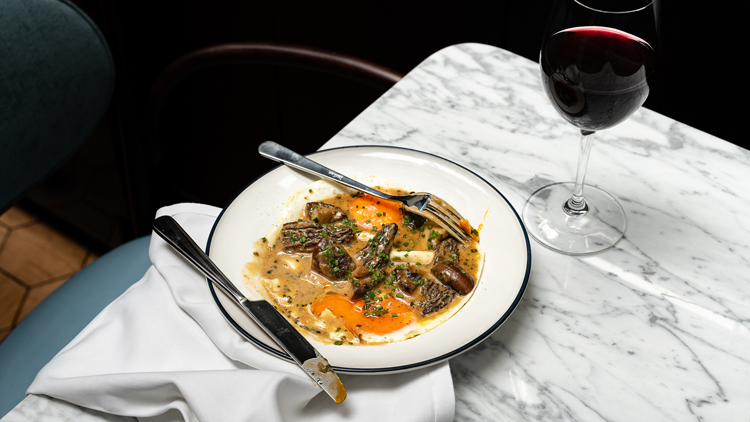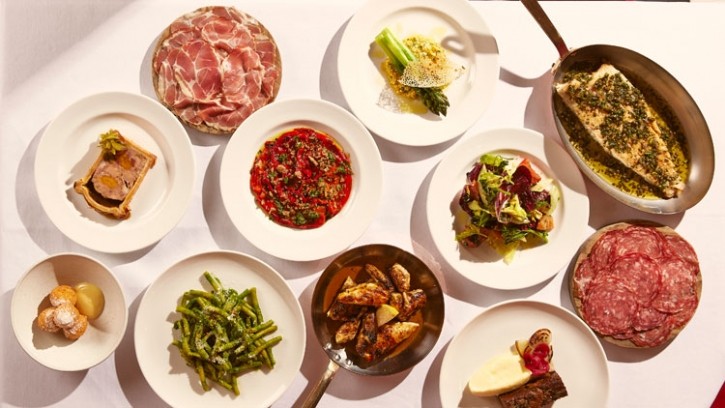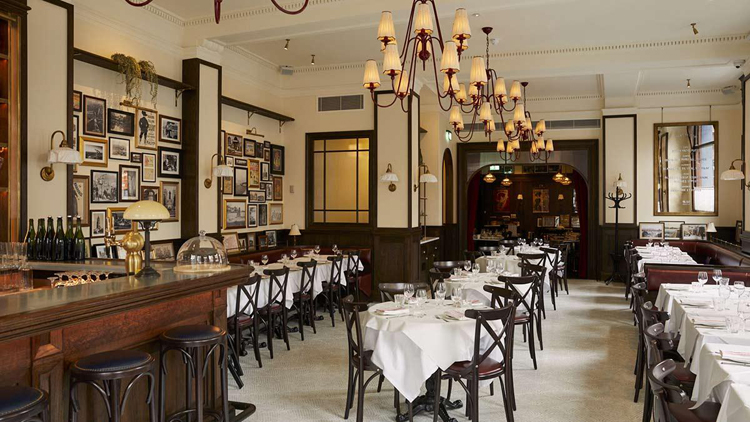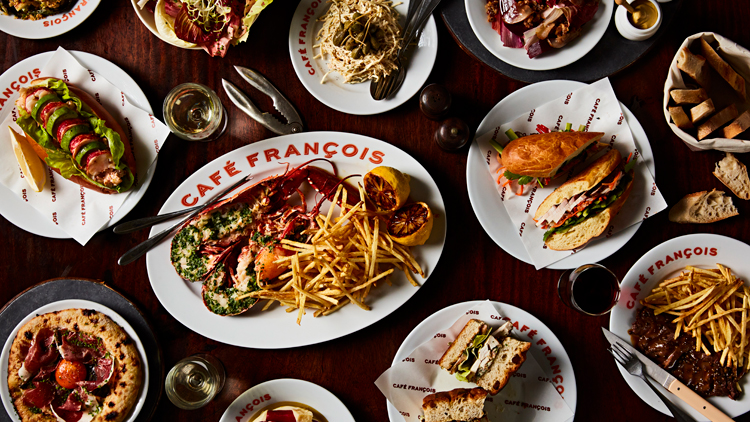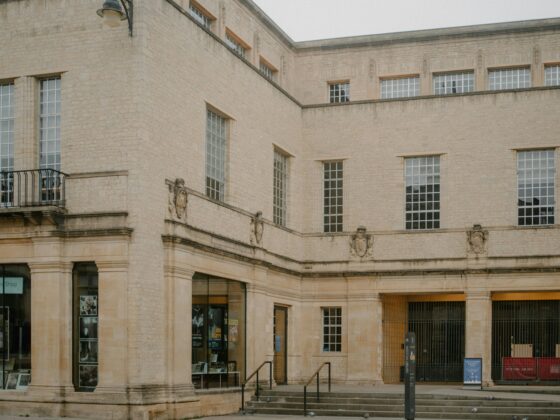When it opens this month, Café François will arguably serve one of the most competitively priced steak frites in all of London. Priced at just £18 and featuring bavette served with a peppercorn sauce, it is one of two major French-focused restaurants to open in the capital this summer to feature the staple brassiere dish on its menu for under £20. The other is Marceline in London’s Wood Wharf, which offers a generous piece of onglet with fries and maître d’hotel butter for £19.
Both Café François and Marceline fall into a growing category of rustic and contemporary French bistros popping up in London and beyond that appear neatly positioned to offer diners a more accessible form of fine dining. Henry Harris’ Bouchon Racine led the charge a few years back and, more recently, it has been joined by Jackson Boxer’s Henri in Covent Garden; Bar Levan in Peckham; Anthony Demetre’s Bistrot at Wild Honey in St James; and Josephine Bouchon in Chelsea.
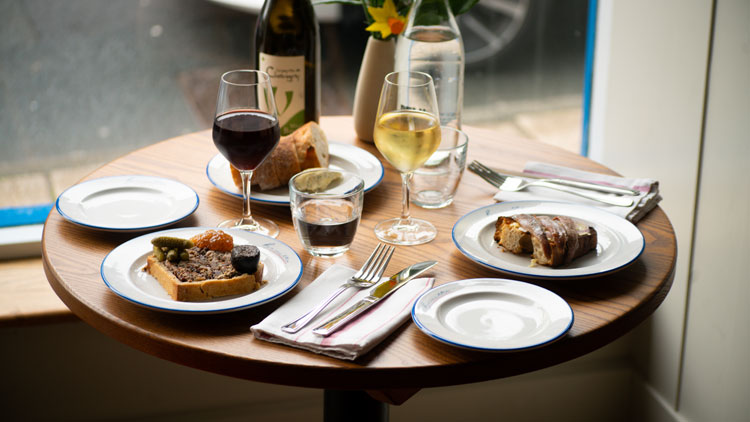
It’s not just a London trend, either. Back in March, Sandy Jarvis and Clément Cousin opened Bavette in Leeds. The neighbourhood-style restaurant, described by Jarvis as having a quite traditional Parisian bistro style, was named Britain’s Best Local Restaurant by The Good Food Guide earlier this summer. So, what’s behind this current amour with the bistro food of France?
An enduring appeal
Since the time of the Roux brothers and even before, French cuisine has long been a dominant fixture of the UK dining scene. As Café Francois co-founder François O’Neill says: “There’s always been an ode to French dining in UK restaurants,” noting also the prominence, particularly in the 90s and 00s, of French casual dining chains like Côte Brasserie and Café Rouge, which both once operated large UK-wide estates. However, he also acknowledges that in more recent times the market has seen a lot of chefs opening small independent restaurants with a view to great French bistro food and good natural wine.
Boxer, who cooked under chef Margot Henderson and launched his first restaurant, Brunswick House in Vauxhall, at the age of just 24, is one of them. Boxer describes himself as a Londoner who ‘learnt to cook in London but learnt to eat in Paris’ and while there have often been Gallic nods in his cooking, Henri is his first dedicated French restaurant.
“There’s always been an ode to French dining in UK restaurants”
The project reflects an ongoing partnership between Boxer and French-founded restaurant and bar operator Experimental Group. For Boxer, Henri was an opportunity to give Experimental founders Olivier Bon, Pierre-Charles Cros and Romée de Goriainoff a restaurant that embodied their French heritage. “They were looking for what to do with their London site and didn’t have anything distinctively reflective of their Parisian roots,” he explains.
There were, however, other motivations. “London is in the midst of some economic turbulence,” he continues. “I’ve spent the last 15 years cooking for other Londoners, and I now find myself in an economy where those Londoners can no longer afford to eat in restaurant in the way that they used to, which has caused some soul searching. And that has been ameliorated by the flooding of tourists from overseas.
“What’s been interesting is seeing what easily translates about contemporary London dining for an international audience and what doesn’t. And, to put it bluntly, there’s a greater familiarity among international visitors conceptually with French dining iconography than modern British.”
When Boxer thought about what he could do with the Henri site, which is in the heart of Covent Garden, a huge tourist destination, he says he wanted to create “something instantly legible and coherent” for people from all over the world. “Playing with the iconography of Parisian bistro culture felt alluring in that regard.”
Tackling a decline in fine dining
More broadly, Boxer believes more approachable French cuisine holds the power to ameliorate the apparent decline being seen across the fine dining space (he says he has friends who run fine dining restaurants who are finding it hard).
“London is a big and wealthy city, but a vast majority of the people living in it suddenly do not feel like they have the money to spend three figures on dinner. Their cost of living has gone up so much, but they still want to eat out.”
The move to more rustic French cooking allows Boxer to retain the classic training that he, and many fine dining chefs have had, but appeal to a slightly more money conscious consumer.
“As a cook, I don’t necessarily want to cook cheap food,” he adds. “I still want it to have technical and creative demands of me that I find satisfying, and in French bistro food you have a pleasing symphysis of classic technique, of proper sauce making and proper stocks, of things done with rigour and attention to detail, and clarity and focus of purpose, but you also have a great tradition of using cheaper cuts, so it’s entirely possible to create a dish that uses a sauce that takes a multi-day prep, but then serving it on a cheaper cut like onglet and bavette.”
The menu at Henri itself features examples of this. It includes a Swaledale bavette served with a rich umami sauce of XO cognac and wild peppercorns, priced at £29; a snack of fried pig’s trotter with Agen prune and a bier mustard; and bowl of rice cooked in veal stock and served with grilled snails covered in green garlic.
“You have a culinary language there that’s quite apposite for the time, which allows us to cook the food we find interesting, rewarding and delicious, but package it up and present it in a way that’s affordable in a world that for a lot of people has become quite unaffordable.”
A cyclical trend
Across town, Anthony Demetre, who during his career has run some of London’s most iconic French restaurants including Arbutus, Wild Honey and Les Deux Salons, has his own thoughts on the matter. “The bistro has been around for many, many years and it’s fallen in and out of fashion,” he says. “You could say the recent momentum we’ve seen in the space is reflective of the cost of living, but I think it’s a red herring. London has always been immune to cost-of-living crises.”
In Demetre’s eyes, there is no causality to be drawn between the recent spate of casual French restaurants opening and the state of the fine dining landscape. Instead, he attributes it to chefs merely choosing to cook what they want – which seems increasingly to be French bistro food.
“You could say the recent momentum we’ve seen in the space is reflective of the cost of living, but I think it’s a red herring.
London has always been immune to cost-of-living crises”
“There’s new bistro restaurants opening all the time, but then there’s always new fancier restaurants launching that would be classed as fine dining. These things are cyclical; I wouldn’t put it down to any particular reason. London and the UK is abundant with good cooks, I believe this is the food they like to eat, and it’s the food they cook at home.”
When it opened back in April, Bistrot at Wild Honey was billed as a less formal little sister to the chef’s Michelin-starred Wild Honey St James restaurant. Occupying the lower-level space that was previously an extension of the Wild Honey St James dining room, the bistro features an all-day menu and is inspired by the ‘bistronomy’ movement.
Certainly, the menu is more accessible. Wild Honey St James’ three course set dinner comes in at £95, while the price point at Bistrot at Wild Honey is closer to £50 per head for food. Dishes have a heartier, more rustic quality, too. The menu includes brassiere classics including rabbit simmered in white wine and mustard ‘à la moutarde’ for £26; and a steak frites with peppercorn sauce that’s made using Herefordshire bavette at £36.
Yet while the prices may be more approachable for diners, Demetre notes that his costs haven’t reduced. From a business standpoint, what the Bistrot concept offers is a chance for him and his team to make the most of the both the restaurant space and the produce they buy in. For example, the rabbit dish features the same Loire Valley rabbit used in the Wild Honey St James kitchen for the dish of roast saddle, slow-cooked shoulder pastilla, summer vegetables, and Lime Bay English mead-scented sauce.
Accessible French food
Claude Bosi is another Michelin-starred chef who has turned his hand towards a more rustic style of French cooking. Launched in Chelsea in March in partnership with his wife Lucy, Josephine Bouchon has proved to hit with both diners and critics.
Described as a love letter to the traditional bouchons of Lyon and billed as the chef’s most personal project to date, Josephine Bouchon’s menu is extensive, with classic bistro dishes such as French onion soup, oeuf en gelée, terrine de campagne; rabbit in mustard sauce; and veal sweetbread in morel sauce. But there’s also many specifically Lyonnaise dishes that are less commonly found on French menus in the UK such as pike mousse with crayfish sauce; tripe sausage with Dijon mustard sauce; and poached eggs, red wine sauce, mushroom and bacon.
Compared to the rest of his London portfolio, which includes the two Michelin-starred Bibendum, also in Chelsea, the newly two-starred Brooklands at The Peninsula, and Mayfair’s more casual but still pretty spendy Socca, Bosi sees Josephine more as a neighbourhood style restaurant, albeit one that retains his eye for detail. “A bistro for me has always been about providing an offering that you can have two or three times a week if you want,” he says.
The produce is still expensive, though, he adds. “I will always buy the same quality of produce, and we charge what we have to charge, so we have to be cleverer about the menu.”
Josephine is refreshingly inexpensive, especially when compared to the rest of Bosi’s portfolio (Brooklands does offer a £58 express lunch). Indeed, the restaurant’s menu de canut gives the likes of Côte a run for its money, offering two courses for £24.50 or three courses for £29.50. There’s also a daily-changing plat du jour option priced at £15.50.
“Josephine was a chance to do classic dishes we don’t see that much anymore,” Bosi continues. “It’s something I’ve wanted to do since I came to the UK and similar to the restaurant my parents had in France. The philosophy behind it is value for money, and somewhere you can come and not be frightened, and bring any one with you.”
Going ‘full French’
When O’Neill and his business partner Ed Wyand launched their first restaurant, Maison François, in St Jame’s between lockdowns back in 2020, they spent a lot of the timing leading up to the opening going back and forth on whether to write the menu in English or French. Eventually, they decided on the latter.
“That really defined the direction of the restaurant,” says Wyand. “And focused everyone’s mind on what we were trying to achieve.”
“A lot of people advised us against it,” adds O’Neill. “But we were very confident about going full French in our menu. There was a point where we considered being more adaptable to broader tastes and personality, but then we went deep into what made classic French cooking great.”
Working with executive chef Matthew Ryle, O’Neill and Wyand played with the tropes of classic French cuisine, often fusing them with a contemporary lens. Signature dishes at Maison François include the moules marinière flatbread; the oeuf en gelée; pâté en croute; and Comté gougères.
“We really enjoyed playing on the French theme, but bringing some modernisation to it,” says O’Neill “People came out of lockdown a little more discerning and wanted that experience, and we offered a fresh approach, in both the food and the service.”
This idea of innovation has been carried forward by the pair for their new opening, Café François, the duo’s vision of a French canteen that occupies a huge central space in the Borough Yards development. Compared to Maison François, Café François is positioned as a much more casual venture and draws influences from ‘the classic cafés of Paris, contemporary delis of California and the stylish bistros of Montreal’.
“Maison François I would describe as being brassiere luxe,” explains O’Neill. We have to play to that St James’s market. But with Café François we can be a bit more XXXXX in our choices of what goes on the menu, while remaining traditional.”
The menu at Café François pays homage to ‘much loved’ affordable French classics, while also embracing global influences and flavours. Several signatures from the Maison François menu feature, including the aforementioned moules marinière flatbread, yet much of the menu is new and includes many more conventional brassiere dishes including rôtisserie chicken; quiche and salad; a steak frites; or a whole lobster. As Wyand says: “It’s a restaurant for all day and for everybody”.
What was behind their reason to follow up Maison François with something more casual?
“It’s cyclical, of course. What you’ve seen in the last couple of years is a return to casual, and a return to simple,” explains Wyand.
“That big ticket meal is for occasions, people want something more approachable in the day to day. And French food really is the epitome of those things.”


